10 EXCEL functions that ACCOUNTERS often use
Using excel and functions in excel is one of the basic skills that accountants must be proficient. In Excel, there are many functions that can help accountants in daily data entry, but here are some of the most commonly used accounting functions.
1. SUMMER, AVERAGE

SUMMER, AVERAGE
- Syntax: = SUM (number 1, number 2, ., number or range of data)
Meaning: A function to sum values
For example: = SUM (4,5,1) => Result = 10
- Syntax: = AVERAGE (value 1, value 2, value 3, . value n or data range)
Meaning: A function that returns the average of the parameters entered or of a data area
For example: = SUM (7,8,9) => Result = 8
2. SEARCH (VLOOKUP)
- V stands for Vertical meaning vertical (vertical). Lookup is a reference and search function
VLOOKUP means search vertically, by column
- Syntax: = VLOOKUP (x, reference region, nth column, 0)
Meaning: take a value (x) to compare by the column of the reference region to return the value in the corresponding column in the reference area (the nth column), 0: compare the dark, 1: absolute comparison dark
Attention:
- Reference region: the first column of the reference must cover only the entire search values adequately.Always have to be at absolute value
- The column to count counts as to how much it is in the reference table.When counting must count from left to right
3. FUNCTION IF
- Syntax: = If (Logical_test, [value_if_true], [value_if_false]) means If (Condition, value 1, value 2)
Meaning: A function that returns value 1 if the condition is true, the function returns value 2 if the condition is false
Example: Given a student's transcript, review the results to see if the student passed or had to retake the test
With the following data sheet:
Average score> = 5: Do
Medium score
We use the formula for cell D6 as: = IF (C6> = 5, "Do", "Retake")
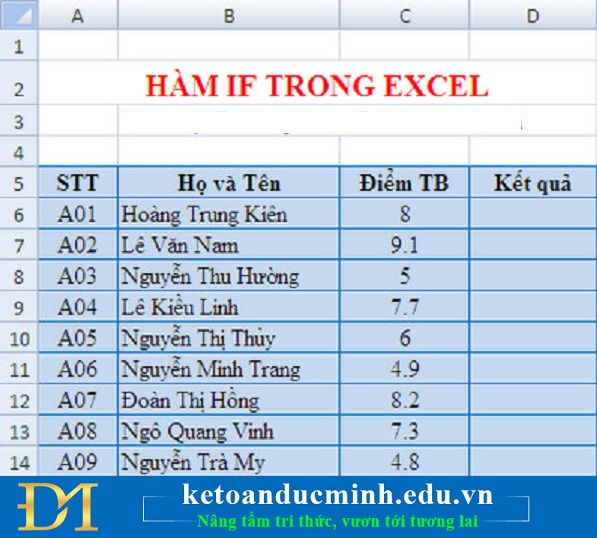
FUNCTION IF
You have got the results of students passing or retesting
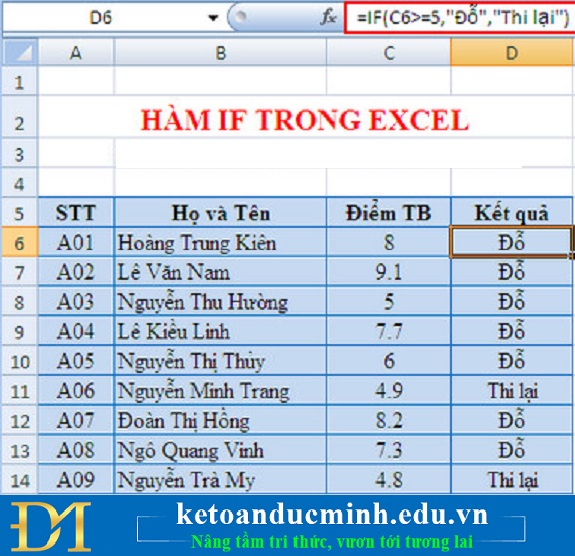
FUNCTION IF
4. SUMIF
- Syntax: = SUMIF ((range, criteria, sum_range) means Sumif (Conditional container, conditional, sum area)
Meaning: This function returns the sum of the cells in the range to satisfy a given condition
Attention:
- Due to calculations in Excel cells, SUMIF function sums on Excel 2016, Excel 2013, or earlier versions like Excel 2010, 2007, 2003 applying the same function structure.
For example: The problem of using SumIF function to calculate the allowances for those who have the position of "Staff" in the table below:
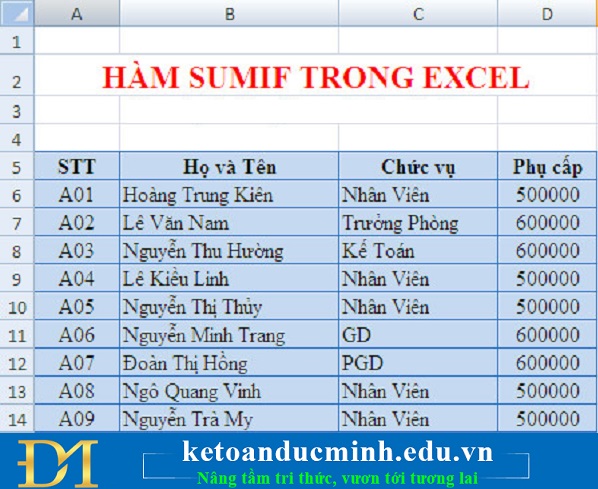
SUMIF
With the formula for cell D15 is: = SUMIF (C5: C14, "Staff", D5: D14)
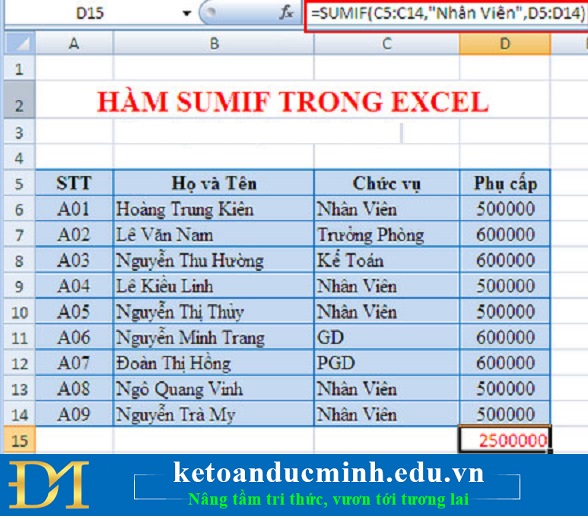
SUMIF
We get the following result: 2500000. When we check the results, we find that in the VD Sumif function there are 5 people with the position of "Staff", so the total allowance for those people with the result is 2500000 is correct.
5. AND AND OR
- Syntax: = AND ((Logical1; [Logical2]; [Logical3]; .) means And (against 1, against 2, .)
Meaning: This function is AND AND, true only when all arguments are true.The arguments are constants, logical expressions
Attention:
- The AND function has up to 256 arguments that must be logical values or arrays or references that contain logical values.All values will be ignored if an array or reference argument contains text or empty cells.
- The arguments must be either logical values or arrays that contain logical values.
- If the reference arguments are text values or null (null) then those values are ignored.
- If the reference range does not contain a logical value, the function returns the #VALUE! Error.
Example 1: Use the AND function to know if the following formulas are true or false.
Browse students' names and genders right or wrong
With the formula in C6: = AND (A6 = "Nguyen Van Dat", B6 = "Nam")
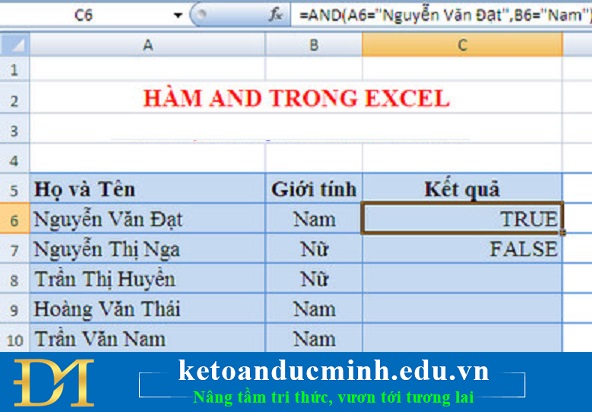
AND FUNCTION
If true, the result will be TRUE
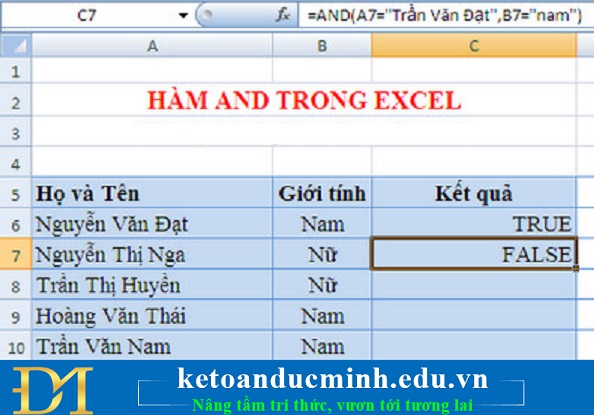
AND FUNCTION
Otherwise, you will get FALSE
- Syntax: = OR (((Logical1; [Logical2]; [Logical3]; .) means Or (against 1, against 2, .)
Meaning: This function is OR OR, false only when all arguments are false
For example: = OR (F7> February 3, 76, F7> January 1, 2016)
6. COUNTIF

COUNTIF
- Syntax: = COUNTIF (range, criteria)
Inside:
Range: is the data range that you want to count conditionally.
Criteria: the condition for a cell to be counted.
Meaning: The Excel COUNTIF function is used to count the number of cells that meet the criteria (Criteria) in the range (Range).
Example: = COUNTIF (B4: B1, '> 500 ″)
This means counting all the cells in the B4: B12 series that contain numbers greater than 500
7. MIN, MIN, MAX

MINUTES MIN, MAX
- Syntax: = MAX (number 1, number 2, .)
Meaning: Returns the maximum value of number1, number 2, . or the maximum value of a whole range of numeric data.
Example: MAX (10,20,30) = 30
- Syntax: = MIN (number 1, number 2, .)
Meaning: Returns the smallest value of number1, number 2, . or the smallest value of a whole range of numeric data
Example: Min (10,20,30) = 10
8. FUNCTION LEFT, RIGHT
- Syntax: = LEFT (string, character to be retrieved)
Meaning: To separate characters to the left of the string
For example: = LEFT ('THANH HUE', 4) => Result: = THANH
- Syntax: = RIGHT (string, characters you want to retrieve)
Meaning: To separate characters to the right of the string
For example: = LEFT ('THANH HUE', 3) => Result: = HUE
9. SUBTOTAL FUNCTION

FUNCTION SUBTOTAL
- Syntax: = SUBTOTAL ((function_num, ref1, [ref2], .)
Inside:
- Function_num: Required.Numbers 1-11 or 101-111 specify the function used for subtotals.1-11 include hidden rows manually, while 101-111 excludes them;Filtered cells will always be excluded.
- Ref1 Required.The first named range or reference for which you want to subtotal.
- Ref2, . Optional.The range or series is named from 2 to 254 that you want to subtotal for it.
Attention:
- If there are other nested SUBTOTAL functions placed on ref1, ref2, etc., then these nested functions will not be counted to avoid double counting.
- The Function_num argument, if from 1 to 11, the calculated SUBTOTAL function includes values in the dataset (hidden rows).The Function_num argument is between 101 and 111, the SUBTOTAL function only calculates for non-hidden values in the dataset (ignoring the hidden values).
- The SUBTOTAL function will skip counting all rows hidden by the Filter (Auto Filter) command regardless of the Function_num argument used.
- The SUBTOTAL function is designed to calculate vertical columns of data, it is not designed to be horizontal.
- This function only calculates for 2-D data so if the reference data is in 3-D format then the SUBTOTAL function reports the #VALUE error.
10. HAm NOW

HAM NOW
- Syntax: = NOW ()
The NOW function syntax has no arguments
Meaning: The function = NOW () to display the system date and time in the calculation.For example:
You only need to enter the function = now () and press Enter will immediately display the date and time at the current time as shown below.
Attention:
- There may be an error ####, but you just need to drag the cell a little wider and it will be OK
You should read it
- How to fix the SUM function doesn't add up in Excel
- Matrix functions in Excel
- MS Excel - Lesson 5: Excel formulas and functions
- The 10 most useful but often forgotten functions in excel
- Complete financial functions in Excel you should know
- Basic Excel functions that anyone must know
- How to add computers to Excel
- Summary of information functions in Excel
May be interested
- How to use Excel's VALUE function
 excel's value function will convert a string to a digital form, which can be combined with other functions such as left function, right function, mid function.
excel's value function will convert a string to a digital form, which can be combined with other functions such as left function, right function, mid function. - Instructions for using Index function in Excel
 index is a function that returns an array in excel. when using the index function, you get the values in a cell between the column and the row.
index is a function that returns an array in excel. when using the index function, you get the values in a cell between the column and the row. - Tips for working with functions in Excel
 functions that work with excel functions functions are predefined formulas for performing specific calculations, or for manipulating spreadsheets.
functions that work with excel functions functions are predefined formulas for performing specific calculations, or for manipulating spreadsheets. - How to add computers to Excel
 to perform complex calculations on excel or even change units, we can install computers on excel.
to perform complex calculations on excel or even change units, we can install computers on excel. - The MIN and MAX functions (the smallest and largest value functions) in Excel
 the function to return the maximum value (max) and the function to return the minimum value (min) are two common statistical functions used by a lot of people in the process of manipulating and processing data in excel.
the function to return the maximum value (max) and the function to return the minimum value (min) are two common statistical functions used by a lot of people in the process of manipulating and processing data in excel. - Common Excel functions you need to know about accounting
 mastering the common excel functions helps accountants save time and effort compared to conventional manual calculations. today, software tips will list and guide readers on how to use some functions commonly used in accounting.
mastering the common excel functions helps accountants save time and effort compared to conventional manual calculations. today, software tips will list and guide readers on how to use some functions commonly used in accounting. - Differentiate between SUM, SUMIF, SUMIFS and DSUM functions
 whenever you enter a function = sum in a cell in excel, you will get a lot of functions starting with sum and wondering how they are different? this article will help you solve that question.
whenever you enter a function = sum in a cell in excel, you will get a lot of functions starting with sum and wondering how they are different? this article will help you solve that question. - Common calculation functions in Excel
 excel is a spreadsheet that supports functions that help you in the process of calculating and processing data, if you know the calculation functions, how to use them, your work will be processed more quickly.
excel is a spreadsheet that supports functions that help you in the process of calculating and processing data, if you know the calculation functions, how to use them, your work will be processed more quickly. - Basic functions in Excel, calculation formulas and illustrative examples
 if you are new to spreadsheets, basic functions in excel such as sum, min, max, if will help you solve your work quickly and effectively. let's learn with free download now.
if you are new to spreadsheets, basic functions in excel such as sum, min, max, if will help you solve your work quickly and effectively. let's learn with free download now. - How to use NORMDIST function in Excel
 normdist is a function that returns a distribution with a standard deviation and a confirmed average. the normdist function applies in statistics, including hypothesis testing.
normdist is a function that returns a distribution with a standard deviation and a confirmed average. the normdist function applies in statistics, including hypothesis testing.










 Instructions for page numbering and tab settings for paragraphs in Word
Instructions for page numbering and tab settings for paragraphs in Word Power shortcuts in Word that you should know
Power shortcuts in Word that you should know Coloring alternating excel lines not everyone knows
Coloring alternating excel lines not everyone knows The same and different when one line break in Excel
The same and different when one line break in Excel Consistent with the format bar in Word 2003-2013
Consistent with the format bar in Word 2003-2013 5 ways to convert PDF files to WORD
5 ways to convert PDF files to WORD